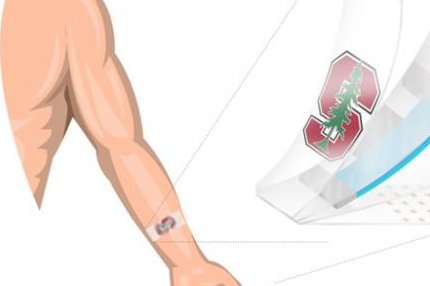The wearable sensor consists of several layers -- including a water-proof collection layer, organic electrochemical transistors and sample reservoir -- to collect and detect cortisol levels. Illustration courtesy of
Stanford University
July 23 (UPI) -- Researchers have developed a prototype patch that measures sweat levels of cortisol, a stress hormone that detects certain medical conditions.
The stretchy patch, when applied directly to the skin, detects sweat and assesses how much cortisol a person is producing. Stanford University scientists, led by materials scientist Alberto Salleo, published the findings Friday in the journal Science Advances.
Currently, it takes several days to get results back from a lab, which can tell if a patient's adrenal or pituitary gland is working properly.
"We are particularly interested in sweat sensing, because it offers noninvasive and continuous monitoring of various biomarkers for a range of physiological conditions," lead author Dr. Onur Parlak, a post-doctoral scholar in the Salleo lab, said in a press release. "This offers a novel approach for the early detection of various diseases and evaluation of sports performance."
The researchers noted that people with an imbalance can monitor their own levels. That includes children young -- even non-verbal -- who might not otherwise be able to communicate that they feel stress.
"Wearable biosensors aim to replace centralized hospital-based care systems with home-based personal diagnostics to reduce healthcare costs and time to diagnosis by providing noninvasive, real-time analysis," the researchers wrote.
A challenge in developing a sensor for sweat was cortisol doesn't have molecular positive or negative charge.
They built the rectangular sensor around a membrane that specifically binds only to cortisol and sucks in sweat through holes in the bottom of the patch. The sweat pools in a reservoir and it is topped by the cortisol-sensitive membrane. A waterproof layer protects the patch from contamination.
Sodium or potassium charged ions pass through the membrane unless they are blocked by cortisol. Those charged ions are detected instead of the cortisol itself.
"I always get excited about a device, but the sweat collection system that Onur devised is really clever," Salleo said. "Without any active microfluidics, he's able to collect enough sweat to do the measurements."
Parlak tested the device on two volunteers, who ran for 20 minutes with the patches on their arms. In the lab and real-world tests, the results were similar to the lab testing.
The parch is connected to a device for analysis.
The researchers want to further develop the patch, including making it part of a fully integrated system and reusable more times.
They said the patch now works again as long as it is not saturated with sweat.
And patients may not need to sweat by trying the cortisol sensor on saliva, they said.















